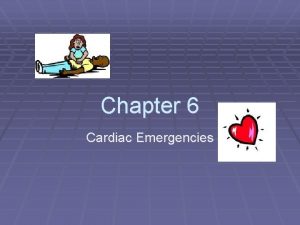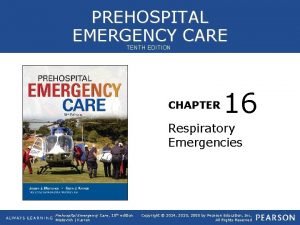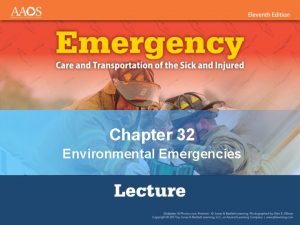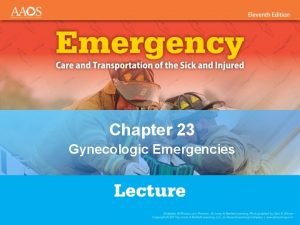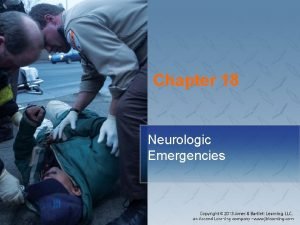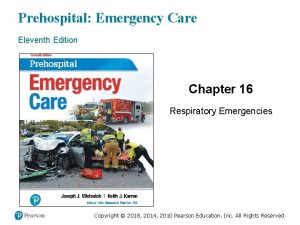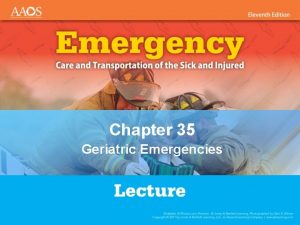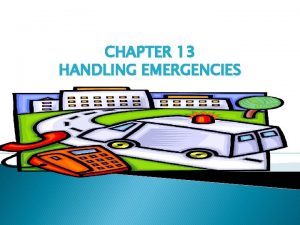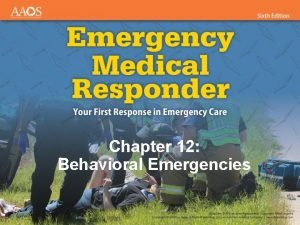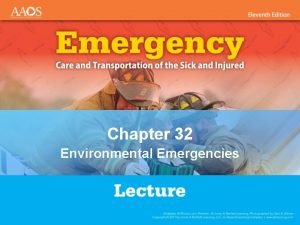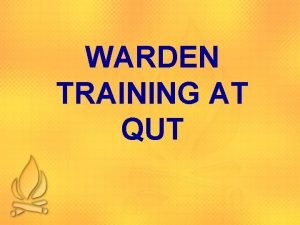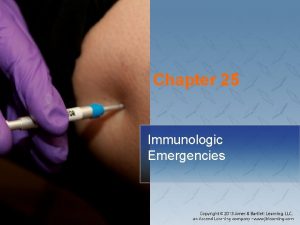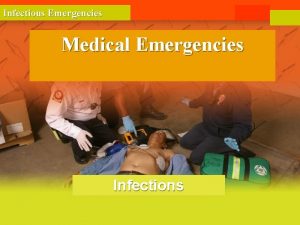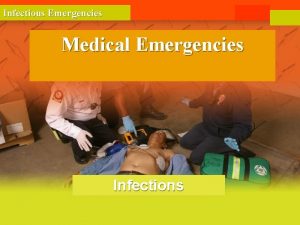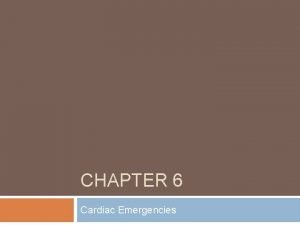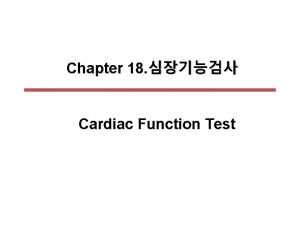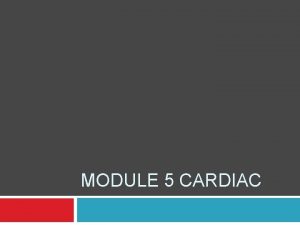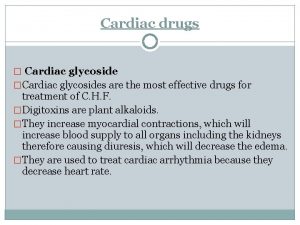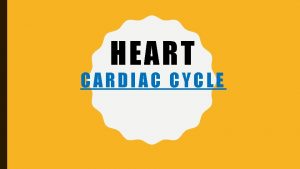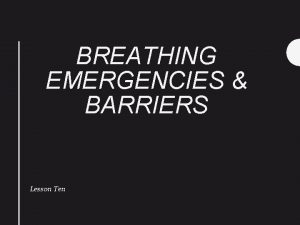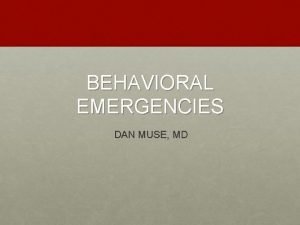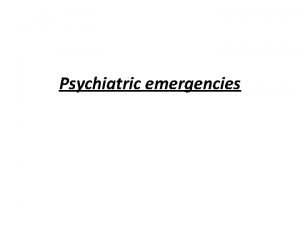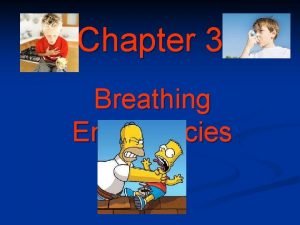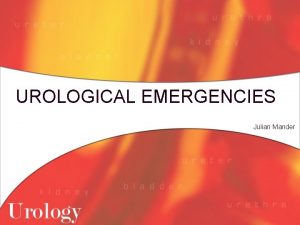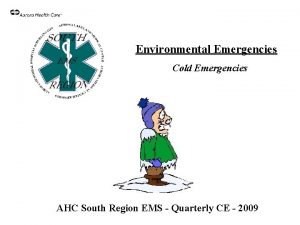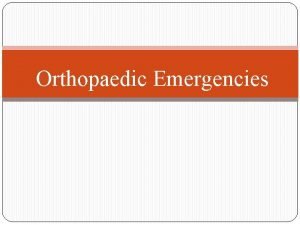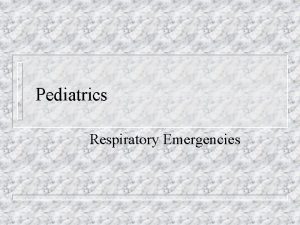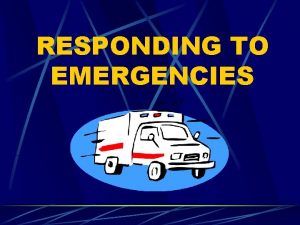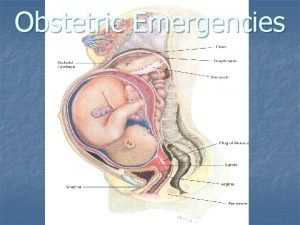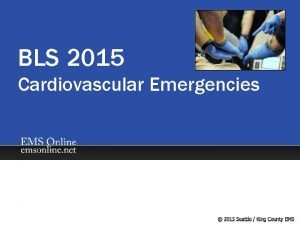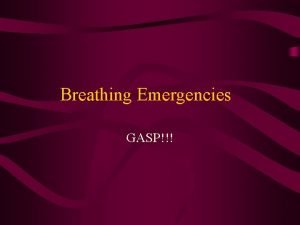Cardiac Emergencies Cardiac Emergencies Introduction Why is the













































- Slides: 45

Cardiac Emergencies

Cardiac Emergencies Introduction ◦ Why is the heart so important? ◦ What happens when the heart stops? If the heart does not function properly a person will die The quicker a rescuer can identify a heart related emergency, the more likely the person will survive

Cardiac Emergencies Students will be able to: Understand how to prevent heart disease Recognize signs and symptoms of a heart attack Provide care for a heart attack victim Understand importance to each link in the Cardiac Chain of Survival

Cardiac Emergencies Terminology Cardiovascular/Heart Disease Leading cause of death in the United States. Caused by lifestyle factors and/or genetics

Cardiac Emergencies Terminology Cardiac Chain of Survival Early recognition/care of heart attack symptoms, and early access to advance medical care. These steps increase the chance of a victim’s survival.

Cardiac Emergencies Terminology Heart attack Heart muscle is damaged from a lack of oxygen & blood supply due to disease or trauma

Cardiac Emergencies Terminology Cardiac Arrest Heart stops beating effectively and blood is no longer circulating.

Cardiac Emergencies Terminology CPR-Cardio. Pulmonary Resuscitation A combination of chest compressions and breaths to provide oxygen to the tissues when the heart is unable to do so.

Cardiac Emergencies AED Terminology Automated external defibrillator Delivers an electric shock to the heart (defibrillation)

Cardiac Emergencies Terminology Defibrillation Re-establishing a normal effective heart rhythm in an individual who is in cardiac arrest

Cardiac Emergencies Terminology Atherosclerosis Build up of fatty substance on the inner walls of the arteries caused by Cholesterol A cause of cardiovascular disease

Cardiac Emergencies Heart disease is the leading cause of death in the United States in both men and women! Taking steps to prevent heart disease is one of the most important things you can do for your health.

Cardiac Emergencies Get into groups of 3 and brainstorm: What are the causes of Cardiovascular Disease. What are the Lifestyle factors that influence Cardiovascular Disease?

Cardiac Emergencies Causes of Cardiovascular Disease: Heredity Age High Cholesterol levels High Blood pressure Diabetes

Cardiac Emergencies Lifestyle Factors that influence Cardiovascular Disease: Diet Smoking Exercise Weight control Drugs and Alcohol

Cardiac Emergencies. Lifestyle Diet/weight control Smoking Drugs/Alcohol Exercise

Cardiac Emergencies Learn to recognize the early signs of a heart attack and take action!

Cardiac Emergencies A person suffering a heart attack still has a beating heart, but due to blockage of heart blood vessels, is not working properly.

Cardiac Emergencies In your same group of 3 brainstorm: What are the signs & symptoms of a heart attack?

Cardiac Emergencies Signs & Symptoms of a heart attack: Most prominent symptom is persistent chest pain or discomfort Many victims deny that they are having a heart attack

Cardiac Emergencies Signs & Symptoms: Chest Discomfort and Pain Pressure Squeezing Tightness Aching Constricting Heavy sensation

Cardiac Emergencies Chest Pain Anything from mild discomfort to unbearable crushing sensation

Cardiac Emergencies Chest Pain May start as pressure under the sternum Can spread to neck, shoulder, arms, jaw or back

Cardiac Emergencies Signs & Symptoms Sweating Shortness of breath/trouble breathing Nausea General ill feeling

Cardiac Emergencies 4 links to cardiac chain of survival Early recognition and action of EMS ◦ The quicker the symptoms of a heart attack are recognized, the quicker 911 can be called ◦ The quicker a heart attack victim can receive care, the more likely they are to survive

Cardiac Emergencies 4 links to cardiac chain of survival Early CPR ◦ When the heart stops the person is in cardiac arrest ◦ CPR is the method of providing chest compressions & breaths to circulate oxygenated blood to the tissues to prolong life

Cardiac Emergencies 4 links to cardiac chain of survival Early CPR ◦ Used until an AED is available or further medical care can be provided ◦ The quicker CPR is started, the better the chance of survival

Cardiac Emergencies 4 links to cardiac chain of survival Early AED ◦ Needed by most victims in cardiac arrest ◦ An electrical shock to the heart which establishes normal, effective heart rhythm again ◦ The earlier the better

Cardiac Emergencies 4 links to cardiac chain of survival Early Advance Medical Care ◦ The quicker EMS is initiated, the quicker the victim will have access to medication & advanced medical care ◦ Provided by EMT’s & paramedics ◦ Transportation to hospital

Cardiac Emergencies 4 links to cardiac chain of survival Early recognition and action of EMS Early CPR Early AED Early Advance Medical Care Each links link is dependent & connected to other

CPR Combination of chest compressions & breaths One cycle consists of 30 chest compressions followed by 2 ventilations 5 cycles every 2 minutes 100 chest compressions per minute 30 compressions in 18 seconds

CPR Start chest compressions ASAP and do quickly Tune of the song “Staying Alive” or “Another One Bites the Dust” Each breath should be about 1 second in length Each breath should make the victim’s chest rise & fall

CPR - Adult Victim must be: Flat on back On a hard surface Rescuer Kneel at the side of victim With your Gluteus maximus off your heels

CPR - Adult Find the Xiphoid Process Place 2 fingers on the Xiphoid Process Put other hand superior to fingers on sternum Hand Placement

CPR - Adult Bottom hand Heel of hand on sternum Place other hand on top of bottom hand Keep fingers off chest Interlock fingers Hand Placement

CPR Elbows locked out Shoulders directly over the Victim Rock at the Hips

CPR - Adult CPR: 2 hands over lower half of sternum Compress victim’s chest 1 1/2 “ – 2” Breathe until chest rises About 1 second per breath 30 compressions : 2 breaths 30 compressions per 18 seconds 100 compressions per minute

Child and Infant CPR Child CPR: 1 or 2 hands on lower half of sternum Compress victim’s chest 1 -1 ½ inches Breathe until chest rises About 1 second per breath 30 compressions : 2 breaths 30 compressions per 18 seconds 100 compressions per minute

Child and Infant CPR: 2 or 3 fingers just below nipple line Compress victim’s chest ½ - 1 inch Breathe until chest rises About 1 second per breath 30 compressions : 2 breaths 30 compressions per 18 seconds 100 compressions per minute

CPR WHEN DO YOU STOP Victim Shows signs of life Scene becomes unsafe AED is ready to use Another trained person can take over or EMS arrives Rescuer is too physically exhausted to continue

CPR Check Scene Safe – Unsafe Check Victim Consciousness Airway – Open - head tilt, chin lift Breathing – Look-Listen-Feel – 10 sec Circulation – Pulse – carotid/brachial Call 911 Care

CPR Care Give 2 rescue breaths Give 30 chest compressions Complete 5 cycles (2 minutes) Re-Check ABC’s

CPR *CPR – Adult - 1: 00 http: //www. youtube. com/watch? v=2 Oc 7 LWNHgm 4&fea ture=related *CPR – Child – : 54 http: //www. youtube. com/watch? v=Svmz. WOu. FWKM&fe ature=related *CPR – Infant – : 40 http: //www. youtube. com/watch? v=kfxe. OP 4 ILb. A&featur e=related

CPR Get with your partner and perform CPR on the manikins Remember to use breathing barriers and clean the manikins between users

CPR Stayin Alive - Bee Gees - video - 3: 55 http: //www. youtube. com/watch? v=IHWeu. Qy. Fouo&feat ure=list_related&playnext=1&list=MLGxd. Cw. VVULXddk lmvd. OPr. Eiq 6 YQDt 3 CS 9 Another One Bites the Dust - Queen - lyrics - 3: 36 http: //www. youtube. com/watch? v=CWs. Jcg-g 1 pg
 Lesson 6: cardiac emergencies and using an aed
Lesson 6: cardiac emergencies and using an aed Hey hey bye bye
Hey hey bye bye Dont ask
Dont ask Padi quiz 1 answers
Padi quiz 1 answers Chapter 16 respiratory emergencies
Chapter 16 respiratory emergencies Major nutritional deficiency diseases in emergencies
Major nutritional deficiency diseases in emergencies Environmental emergencies emt
Environmental emergencies emt Chapter 23 gynecologic emergencies
Chapter 23 gynecologic emergencies During a psychiatric emergency the emt should be able to
During a psychiatric emergency the emt should be able to Chapter 19 endocrine and hematologic emergencies
Chapter 19 endocrine and hematologic emergencies Chapter 18 neurologic emergencies
Chapter 18 neurologic emergencies Emt chapter 18 gastrointestinal and urologic emergencies
Emt chapter 18 gastrointestinal and urologic emergencies Chapter 28 first aid and emergencies
Chapter 28 first aid and emergencies Chapter 16 respiratory emergencies
Chapter 16 respiratory emergencies Dic labs
Dic labs Gems diamond geriatric assessment
Gems diamond geriatric assessment Chapter 13 handling emergencies
Chapter 13 handling emergencies Chapter 12 behavioral emergencies
Chapter 12 behavioral emergencies Chapter 32 environmental emergencies
Chapter 32 environmental emergencies Chapter 16 cardiovascular emergencies
Chapter 16 cardiovascular emergencies Psychiatric emergency
Psychiatric emergency Qut security emergency extension number
Qut security emergency extension number Immunologic emergencies
Immunologic emergencies Chapter 17 neurologic emergencies
Chapter 17 neurologic emergencies Hình ảnh bộ gõ cơ thể búng tay
Hình ảnh bộ gõ cơ thể búng tay Ng-html
Ng-html Bổ thể
Bổ thể Tỉ lệ cơ thể trẻ em
Tỉ lệ cơ thể trẻ em Gấu đi như thế nào
Gấu đi như thế nào Glasgow thang điểm
Glasgow thang điểm Hát lên người ơi alleluia
Hát lên người ơi alleluia Môn thể thao bắt đầu bằng chữ f
Môn thể thao bắt đầu bằng chữ f Thế nào là hệ số cao nhất
Thế nào là hệ số cao nhất Các châu lục và đại dương trên thế giới
Các châu lục và đại dương trên thế giới Cong thức tính động năng
Cong thức tính động năng Trời xanh đây là của chúng ta thể thơ
Trời xanh đây là của chúng ta thể thơ Cách giải mật thư tọa độ
Cách giải mật thư tọa độ 101012 bằng
101012 bằng Phản ứng thế ankan
Phản ứng thế ankan Các châu lục và đại dương trên thế giới
Các châu lục và đại dương trên thế giới Thể thơ truyền thống
Thể thơ truyền thống Quá trình desamine hóa có thể tạo ra
Quá trình desamine hóa có thể tạo ra Một số thể thơ truyền thống
Một số thể thơ truyền thống Cái miệng xinh xinh thế chỉ nói điều hay thôi
Cái miệng xinh xinh thế chỉ nói điều hay thôi Vẽ hình chiếu vuông góc của vật thể sau
Vẽ hình chiếu vuông góc của vật thể sau Biện pháp chống mỏi cơ
Biện pháp chống mỏi cơ
